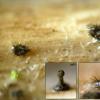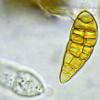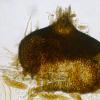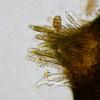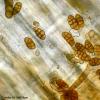
20-12-2025 23:08
Patrice TANCHAUDBonsoir, récolte sur sol sablonneux dans l'arri�

20-12-2025 15:47
Mirek GrycHi.These grew on pine wood that was heavily covere

18-12-2025 21:17
Pol DebaenstThe identification took me to Byssonectria deformi

15-12-2025 07:09
 Danny Newman
Danny Newman
indet. Rutstroemiaceae sp. on unk. fallen leavesMc

19-12-2025 10:10
Patrice TANCHAUDBonjour, récolte réalisée en milieu dunaire, a

18-12-2025 17:23
 Bruno Coué
Bruno Coué
Bonjour,je serais heureux d'avoir votre avis sur c

18-12-2025 18:07
Margot en Geert VullingsThese plumes were found on rotten wood.They strong

17-12-2025 18:35
 Michel Hairaud
Michel Hairaud
Bonjour à tous/Hi to everyone I am passing along
Pleospora on Clematis
Björn Wergen,
24-11-2013 18:45
 Hi friends,
Hi friends,and again, there is an interesting pleosporaleous species growin on dead Clematis stems with distinct setae on the black, hemisphaerical pseudothecia and clavate, 7-8 septated ascospores, which have indistinct, hyaline appendages on both endings (upper ending with hemisphaerical, lower one with conical appendage).
Spores are 25-31x8-10µm, asci 100-130x15-20µm, short stalked and biseriate. I have also found conidial state of very small, beaked conidiomata with Stemphylium-like conidiospores of 14-19x7-9µm.
After comparing several species with Wehmeyer, I have the idea of Pleospora dura, which has tomentose hairs instead of the stiff setae I have recorded. Probably you can tell me something about the relation in Pleospora with their conidial states. In Wehmeyer 1961, P. herbarum is described as attended by Stemphylium state.
I think its time to read Wehmeyer's works...Pleospora is still undeterminable for me :(
[NFF = anamorph, HFF = teleomorph]
Thanks to everyone who can tell me something about it.
regards,
björn
Björn Wergen,
24-11-2013 19:01

Re : Pleospora on Clematis
P. ambigua has many similarities, even if it is figured very different. Wehmeyer gives matching spore and ascus sizes and, more important, distinct stiff hairs and many substrates for this species.
He only describes the spores as "dark yellow brown to red brown"...
He only describes the spores as "dark yellow brown to red brown"...
Alain GARDIENNET,
24-11-2013 20:09
Re : Pleospora on Clematis
Hi Björn,
Perhaps have you to look towards Cilioplea species.
Alain
Perhaps have you to look towards Cilioplea species.
Alain
Björn Wergen,
24-11-2013 20:30

Re : Pleospora on Clematis
Yes you are so right, its Cilioplea coronata...oh man diese blöden Ascomyceten immer ^^
:D Thanks Alain!
regards,
björn
:D Thanks Alain!
regards,
björn
Yannick Mourgues,
24-11-2013 23:55

Re : Pleospora on Clematis
Yes, Alain is right again !
Cilioplea Munk, Dansk Bot. Ark.15(2) : 113, 1953 is a genus that shows ascocarps with short apical setae.
I remember that C. kansensis have hyaline /yellowish setae and C. coronata brown setae. Here it's clearly C. coronata !
Beautiful discovery!
Cilioplea Munk, Dansk Bot. Ark.15(2) : 113, 1953 is a genus that shows ascocarps with short apical setae.
I remember that C. kansensis have hyaline /yellowish setae and C. coronata brown setae. Here it's clearly C. coronata !
Beautiful discovery!

